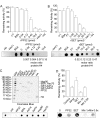PP32 and SET/TAF-Iβ proteins regulate the acetylation of newly synthesized histone H4
- PMID: 28977641
- PMCID: PMC5714232
- DOI: 10.1093/nar/gkx775
PP32 and SET/TAF-Iβ proteins regulate the acetylation of newly synthesized histone H4
Abstract
Newly synthesized histones H3 and H4 undergo a cascade of maturation steps to achieve proper folding and to establish post-translational modifications prior to chromatin deposition. Acetylation of H4 on lysines 5 and 12 by the HAT1 acetyltransferase is observed late in the histone maturation cascade. A key question is to understand how to establish and regulate the distinct timing of sequential modifications and their biological significance. Here, we perform proteomic analysis of the newly synthesized histone H4 complex at the earliest time point in the cascade. In addition to known binding partners Hsp90 and Hsp70, we also identify for the first time two subunits of the histone acetyltransferase inhibitor complex (INHAT): PP32 and SET/TAF-Iβ. We show that both proteins function to prevent HAT1-mediated H4 acetylation in vitro. When PP32 and SET/TAF-Iβ protein levels are down-regulated in vivo, we detect hyperacetylation on lysines 5 and 12 and other H4 lysine residues. Notably, aberrantly acetylated H4 is less stable and this reduces the interaction with Hsp90. As a consequence, PP32 and SET/TAF-Iβ depleted cells show an S-phase arrest. Our data demonstrate a novel function of PP32 and SET/TAF-Iβ and provide new insight into the mechanisms regulating acetylation of newly synthesized histone H4.
© The Author(s) 2017. Published by Oxford University Press on behalf of Nucleic Acids Research.
Figures






Similar articles
-
A signaling role of histone-binding proteins and INHAT subunits pp32 and Set/TAF-Ibeta in integrating chromatin hypoacetylation and transcriptional repression.J Biol Chem. 2004 Jul 16;279(29):30850-5. doi: 10.1074/jbc.M404969200. Epub 2004 May 10. J Biol Chem. 2004. PMID: 15136563
-
Highly acidic C-terminal domain of pp32 is required for the interaction with histone chaperone, TAF-Ibeta.Biol Pharm Bull. 2006 Dec;29(12):2395-8. doi: 10.1248/bpb.29.2395. Biol Pharm Bull. 2006. PMID: 17142970
-
Thanatos-associated protein 7 associates with template activating factor-Ibeta and inhibits histone acetylation to repress transcription.Mol Endocrinol. 2006 Feb;20(2):335-47. doi: 10.1210/me.2005-0248. Epub 2005 Sep 29. Mol Endocrinol. 2006. PMID: 16195249
-
Recent insights into Histone Acetyltransferase-1: biological function and involvement in pathogenesis.Epigenetics. 2021 Aug;16(8):838-850. doi: 10.1080/15592294.2020.1827723. Epub 2020 Oct 4. Epigenetics. 2021. PMID: 33016232 Free PMC article. Review.
-
Histone acetyltransferase 1: more than just an enzyme?Biochim Biophys Acta. 2012 Mar-Apr;1819(3-4):256-63. doi: 10.1016/j.bbagrm.2011.07.006. Epub 2011 Jul 18. Biochim Biophys Acta. 2012. PMID: 24459728 Free PMC article. Review.
Cited by
-
JMJD1B, a novel player in histone H3 and H4 processing to ensure genome stability.Epigenetics Chromatin. 2020 Feb 18;13(1):6. doi: 10.1186/s13072-020-00331-1. Epigenetics Chromatin. 2020. PMID: 32070414 Free PMC article.
-
Human TAF-Iα promotes oncogenic transformation via enhancement of cell proliferation and suppression of apoptosis.In Vitro Cell Dev Biol Anim. 2021 May;57(5):531-538. doi: 10.1007/s11626-021-00572-8. Epub 2021 May 21. In Vitro Cell Dev Biol Anim. 2021. PMID: 34021475
-
SET facilitates immune escape of microsatellite stability colorectal cancer by inhibiting c-Myc degradation.Cancer Sci. 2025 Jan;116(1):29-43. doi: 10.1111/cas.16368. Epub 2024 Oct 17. Cancer Sci. 2025. PMID: 39420583 Free PMC article.
-
SET alpha and SET beta mRNA isoforms in chronic lymphocytic leukaemia.Br J Haematol. 2019 Feb;184(4):605-615. doi: 10.1111/bjh.15677. Epub 2018 Nov 15. Br J Haematol. 2019. PMID: 30443898 Free PMC article. Clinical Trial.
-
Unveiling RCOR1 as a rheostat at transcriptionally permissive chromatin.Nat Commun. 2022 Mar 23;13(1):1550. doi: 10.1038/s41467-022-29261-0. Nat Commun. 2022. PMID: 35322029 Free PMC article.
References
-
- Marzluff W.F., Duronio R.J.. Histone mRNA expression: multiple levels of cell cycle regulation and important developmental consequences. Curr. Opin. Cell Biol. 2002; 14:692–699. - PubMed
MeSH terms
Substances
LinkOut - more resources
Full Text Sources
Other Literature Sources
Research Materials
Miscellaneous

